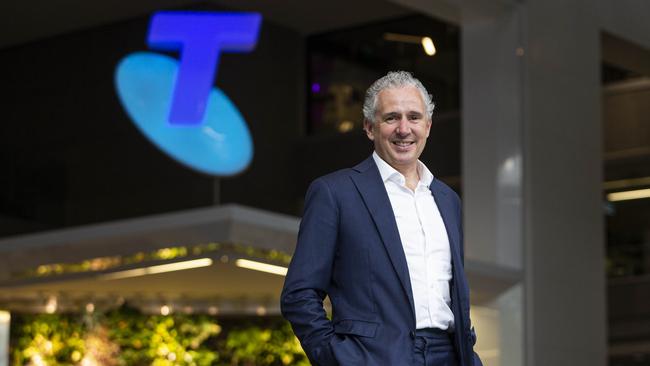Telstra maintains dividend despite COVID hit
Telstra shareholders will hang on to their payouts even after income slumped and COVID-19 and the NBN hit its bottom line.

Telstra has weathered the worst effects of the duelling issues of the COVID-19 pandemic and fiscal headwinds created by the NBN, according to its chief executive Andy Penn, who declared on Thursday that his telco had passed a significant turning point and was ready to reap the benefits of its T22 cost-cutting program.
Telstra’s income dropped by more than 10 per cent for the first half of the year, it reported on Wednesday, but the telco will maintain its 8 cent dividend, worth about $950 million to shareholders.
In its half year results Telstra on Thursday said it would pay a 5 cent interim dividend and a 3 cent special dividend. Combined with an expected 8 cent dividend at the full year, the total dividend for FY21 will be 16 cents per share.
“This is a significant year for Telstra. It represents a turning point for the company in our T22 journey, and a turning point in our financial outlook,” Mr Penn told investors.
“For the last four years, every year, we’ve had to face the confronting challenge of the financial headwinds, which arise from the transfer of a material part of our business to the NBN...Now we are substantially through the T22 program, and it is delivering significant benefits leading to a financial turnaround.”
The company posted revenue for the first half of $10.98bn, down 9.7 per cent, while total income was down 10.4 per cent to $12bn. Profit was down 2.2 per cent to $1.13bn. Mobile revenue declined due to lower hardware sales, the company said.
Reported earnings before interest, taxation, depreciation and amortisation (EBITDA) slumped 14.7 per cent to $4.1bn, while underlying EBITDA fell 14.2 per cent to $3.3bn.
Telstra chief Andy Penn said an NBN headwind of $370m and an estimated $170m hit from COVID-19 were to blame for the downturn, and that underlying EBITDA would have otherwise been broadly flat.
“After a decade of disruption following the creation of the NBN, and with its rollout now declared complete, we can clearly see the path to underlying growth ahead of us,” Telstra chief Andy Penn said.
“We responded strongly to the financial headwinds created by the NBN through our T22 strategy. This strategy is transforming Telstra while balancing the needs of our customers, our employees and shareholders. We are now less than 18 months from completing T22.”
Telstra investors welcomed the results, sending shares up 2.5 per cent to $3.25.
The company said it added more than 80,000 postpaid handheld mobile services for the half, and 46,000 new prepaid handheld users. Postpaid handheld average revenue per user declined 8.6 per cent for the half.
Chief financial officer Vicki Brady said mobile EBITDA on a year-on-year basis will return to growth.
Telstra also said its proposed spin-off of InfraCo Towers was on track to be completed by the end of FY21. Mr Penn flagged that in early FY22, the company would search for external investors for its tower division.
“We are undertaking significant verification and due diligence on our towers and property, appointed key members of the management team and advisers, and preparation work is well advanced to meet our timetable,” Mr Penn said.
Mr Penn also said the company intended to transition to full ownership for all of its branded retail stores across Australia. The telco currently owns and operates 60 stores, with a further 166 run by individual licensees, and 104 operated by Vita Group.
The executive revised Telstra’s income guidance down by $1.2bn, citing lower handset device sales.
Analysts said the challenging results had been slightly better than expected.
“Telstra has continued to report revenue declines over the past few years, as intense competition in the mobile sector and the transition to the NBN have placed downward pressure on company earnings,” said IBISWorld Senior Industry Analyst Liam Harrison.
“The NBN has been a thorn in Telstra’s side for years, with the switch away from legacy products eroding company profitability. The COVID-19 pandemic has hit Telstra mobile products hard, and the rollout of 5G services has not been enough so far to stem the bleeding of this segment.”
Mr Harrison added that Telstra had some breathing room in the highly competitive telco market, given the merged TPG-Vodafone had yet to take full advantage of expected synergies.
“The ACCC’s attempt to block the TPG-Vodafone merger has significantly delayed the synergies that TPG would gain from the merger, allowing Telstra to more easily respond to the threat of the newly merged company,” he said.
He said Telstra will likely continue suffering revenue declines over the next year, as it continues to roll out its T22 strategy.
Aberdeen Standard Investments analyst Natalie Tam said the company’s consumer business had held up better than was expected during the COVID-19 pandemic.
“It was reassuring the board gave dividend guidance, because it shows their confidence in the trajectory of the financial results, and clearly there’s enough cashflow being generated to support the dividend as well,” she said.
“It was pleasing to see they upgraded their cost cutting program guidance by a further $200m, and flagged that they expect additional cost savings post-FY22, which is good. And there are positive events to look forward to, namely the monetisation of InfraCo Towers.”



To join the conversation, please log in. Don't have an account? Register
Join the conversation, you are commenting as Logout